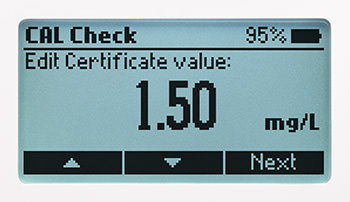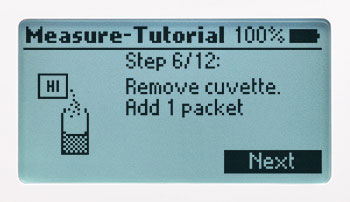Water, with exception of distilled water, contains dissolved salts (magnesium and calcium carbonates). The concentration of these salts determines the water hardness, which can be expressed in calcium carbonate or magnesium carbonate. The sum of these two represents the total hardness level. In addition, water hardness is also related to the phenomenon of pipe rusting in water heating and cooling systems, reverse osmosis, and demineralization plants.
The HI97720 uses an adaptation of the Standard Methods for the Examination of Water and Wastewater, 23rd Edition, calmagite method to measure calcium hardness concentrations of up to 2.70 mg/L (ppm). When the reagent is added to samples containing calcium salts, the sample will turn a red hue; the greater the concentration, the deeper the color. The associated color change is then colorimetrically analyzed according to the Beer-Lambert Law. This principle states that light is absorbed by a complementary color, and the emitted radiation is dependent upon concentration. For calcium hardness determination, a narrow band interference filter at 525 nm allows only green light to be detected by the silicon photodetector and omits all other visible light emitted from the LED lamp. As the change in color of the reacted sample increases, absorbance of the specific wavelength of light also increases, while transmittance decreases.
-
- LED that generates very little heat.
-
- 8 nm narrowband interference filter that is accurate to ±1 nm.
-
- Reference detector that modulates the voltage to LED for consistent light output.
- A concave focusing lens that reduces errors from imperfections in the cuvette.
On-Screen Features

CAL Check
Advanced features including CAL-Check to verify performance and if necessary, recalibrate.

Multiple Chemical Forms
Results can be displayed in multiple chemical forms.

Setup Options
Backlit dot matrix LCD that offers an exceptionally intuitive user interface that is easy to read and understand.

Tutorial Mode
Tutorial mode for step-by-step instructions to guide a first-time user in how to perform a measurement correctly.
HI97720 FEATURES/BENEFITS:
Stable Light Source:
- The internal reference system of the HI97720 photometer compensates for any drifts due to power fluctuations or ambient temperature changes. With a stable source of light the readings are fast and stable between your blank (zero) measurement and sample measurement.
High Efficiency Light Source:
- LED light sources offer superior performance compared to tungsten lamps. LEDs have a much higher luminous efficiency, providing more light while using less power. They also produce little heat, which could otherwise affect electronic stability.
High Quality Filters:
- Improved optical filters ensure greater wavelength accuracy and allow a brighter, stronger signal to be received. The end result is higher measurement stability and less wavelength error.
Greater Light Yield:
- A focusing lens collects all of the light that exits the cuvette, eliminating errors from imperfections and scratches that may be present in the glass. The use of the convex lens reduces the need for indexing cuvettes.
CAL Check Functionality:
- Hanna’s exclusive CAL Check feature allows for performance verification and calibration of the meter using NIST traceable standards. Our CAL Check standard vials are developed to simulate a specific absorbance value at each wavelength to verify the accuracy of subsequent readings.
Large Cuvette Size:
- The sample cell of the HI97720 fits a round, glass cuvette with a 25 mm path length. The relatively long path length of the sample cuvette allows the light to pass through more of the sample solution, ensuring accurate measurements even in low absorbance samples.
Intuitive Dot Matrix Display:
- The HI97720 is designed with a backlit, graphic LCD. With virtual keys, a battery status indicator, and error messages. Users will find the meter interface intuitive and easy to read. A dedicated help key provides information relating to the current meter operation, and can be used at any stage in the setup or measurement process to show contextual help.
Auto-off Protection:
- The meter uses three common AA batteries that allow for about 800 measurements to be taken. The auto-off feature automatically shuts off the meter after 15 minutes of inactivity in order conserve battery life.
Ordering info
HI97720C is supplied with CAL Check standards, cuvettes (2), caps (2), plastic inserts for cuvette, (2), scissors, cuvette cleaning cloth, 1.5V AA batteries (3), instruction manual, and instrument quality certificate packaged in a rugged, thermoformed, carrying case.
HI97720 is supplied with cuvettes (2), caps (2), plastic inserts for cuvettes (2), 1.5V AA batteries (3), instruction manual, and instrument quality certificate.
Purchase & Shipping
All prices are inclusive of GST and not all items are stock items, if you require an immediate solution please send an email to sales@hannainst.com.au or call us on (03) 9769 0666.
Free standard delivery: We offer free delivery within Australia on orders over $150, typically arriving within 5 to 7 days. Delivery times may vary depending on the courier service and the recipient's location. Free shipping is not available with other offers or discounts.
Same-day dispatch: Place your order before 1 PM Monday to Friday for same-day despatch (leaves our warehouse). Delivery times may vary depending on the courier service and the recipient's location. Subject to stock availability.
Please note that we do not offer shipping to PO Box addresses.












